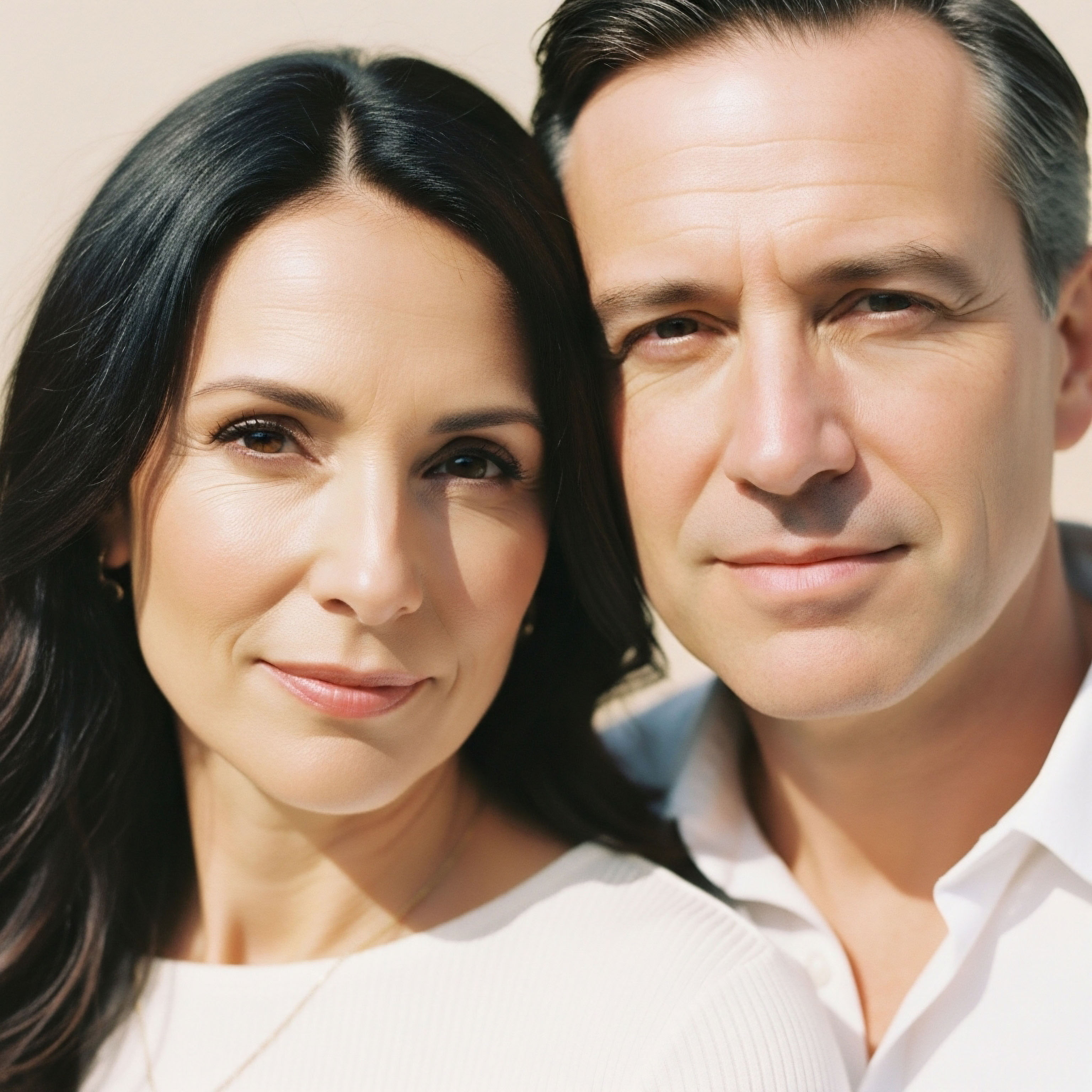

Fundamentals
You feel it before you can name it. A subtle shift in energy, a change in the way your body responds to exercise, or a fog that seems to settle over your thoughts. These experiences are valid, and they are often the first signs of a complex biological conversation happening within your body.
The endocrine system, a sophisticated network of glands and hormones, orchestrates everything from your metabolism to your mood. When one part of this system begins to function differently, the effects can ripple outwards, touching every aspect of your well-being. This is where the integration of peptides with hormonal support protocols becomes a compelling area of personalized medicine.
Understanding the distinction between hormonal support and peptide therapy is the first step. Hormonal optimization, such as Testosterone Replacement Therapy (TRT), involves replenishing a hormone that your body is no longer producing in sufficient quantities. Peptides, on the other hand, are short chains of amino acids that act as signaling molecules.
They do not replace hormones; instead, they communicate with your glands, encouraging them to produce and release your body’s own natural hormones. This creates a more nuanced and sustainable approach to endocrine health.
Integrating peptides with hormonal support can amplify the benefits of each, creating a synergistic effect that promotes overall well-being.
The primary benefit of this integrated approach lies in its ability to address multiple aspects of the aging process simultaneously. While TRT can effectively restore testosterone levels, leading to improvements in energy, libido, and muscle mass, it does not directly address the age-related decline in growth hormone (GH) production.
This is where peptides like Sermorelin or Ipamorelin come into play. By stimulating the pituitary gland to release more GH, these peptides can enhance recovery, improve sleep quality, and promote fat loss. The result is a more comprehensive and holistic approach to health optimization.

The Importance of a Systems-Based Approach
Your body is not a collection of isolated systems; it is an interconnected web of biological pathways. Hormonal imbalances are rarely a single-issue problem. For example, low testosterone can contribute to fatigue, which can lead to a more sedentary lifestyle, which in turn can exacerbate weight gain and further disrupt hormonal balance.
By integrating peptides that support GH production with TRT, you are addressing both the primary hormonal deficiency and the downstream effects of that deficiency. This systems-based approach is a cornerstone of modern personalized medicine.


Intermediate
At the intermediate level of understanding, we move beyond the “what” and into the “how.” How, specifically, do peptides and hormonal support work together to create a synergistic effect? The answer lies in the intricate feedback loops of the endocrine system, particularly the Hypothalamic-Pituitary-Gonadal (HPG) axis and the Growth Hormone (GH) axis.
TRT directly addresses the “gonadal” part of the HPG axis by supplying exogenous testosterone. However, this can sometimes lead to a downregulation of the body’s natural testosterone production. This is where peptides can offer a significant advantage.
Peptides like Gonadorelin, for instance, are often used in conjunction with TRT to maintain the function of the HPG axis. Gonadorelin mimics the action of Gonadotropin-Releasing Hormone (GnRH), which is naturally produced by the hypothalamus.
This signals the pituitary gland to continue producing Luteinizing Hormone (LH) and Follicle-Stimulating Hormone (FSH), which in turn tell the testes to continue producing testosterone and sperm. This integrated approach can help preserve testicular function and fertility, which can be a concern for some men on TRT.

Comparing Hormonal and Peptide Protocols
To better understand the practical applications of integrating peptides with hormonal support, let’s compare a standard TRT protocol with an integrated protocol that includes peptides.
| Component | Standard TRT Protocol | Integrated TRT and Peptide Protocol |
|---|---|---|
| Testosterone | Weekly intramuscular injections of Testosterone Cypionate | Weekly intramuscular injections of Testosterone Cypionate |
| Estrogen Control | Anastrozole as needed to manage estrogen levels | Anastrozole as needed, often at a lower dose due to improved hormonal balance |
| HPG Axis Support | Typically not included | Subcutaneous injections of Gonadorelin to maintain natural testosterone production |
| Growth Hormone Support | Not included | Subcutaneous injections of Sermorelin or a blend like CJC-1295/Ipamorelin to stimulate natural GH release |
The integration of peptides into a hormonal support protocol allows for a more comprehensive and individualized approach to endocrine health.
The integrated protocol offers several advantages over the standard protocol. By supporting the HPG axis, it can mitigate some of the potential side effects of TRT, such as testicular atrophy. Additionally, by stimulating the GH axis, it can address other aspects of the aging process that are not directly impacted by testosterone alone.
This can lead to improved body composition, with studies showing that the combination of testosterone and GH can lead to greater decreases in fat mass and increases in fat-free mass than testosterone alone.
- Enhanced Muscle Growth and Fat Loss ∞ TRT boosts protein synthesis, while peptides that stimulate GH release promote the regeneration of muscle cells and increase fat metabolism.
- Improved Recovery ∞ The combination of TRT and GH-releasing peptides can significantly reduce recovery time after exercise or injury, allowing for more consistent and intense training.
- Better Sleep Quality ∞ Many individuals report improved sleep quality with the addition of GH-releasing peptides, which can have a profound impact on overall health and well-being.


Academic
From an academic perspective, the integration of peptides with hormonal support protocols is grounded in the principles of endocrinology and systems biology. The synergistic effects observed in clinical practice can be explained by the complex interplay between the somatotropic axis (which governs growth hormone) and the gonadal axis (which governs sex hormones). Research has shown that testosterone and growth hormone have complementary and often interdependent effects on protein metabolism, body composition, and overall physiological function.
A key area of investigation is the impact of this combined approach on protein anabolism. Studies using stable isotope infusions have demonstrated that while testosterone alone can decrease protein oxidation rates, the combination of testosterone and growth hormone produces a more significant effect.
This suggests that the two hormones work together to create a more anabolic environment in the body, which can lead to greater gains in lean muscle mass and improved physical performance. Furthermore, the combination has been shown to have a more profound effect on body composition, leading to greater reductions in fat mass and increases in fat-free mass than either hormone alone.

What Is the Cellular Mechanism of Action?
At the cellular level, the mechanisms of action are multifaceted. Testosterone primarily exerts its effects by binding to androgen receptors, which then translocate to the cell nucleus and modulate gene expression. This leads to an increase in the synthesis of contractile proteins in muscle cells.
Growth hormone, on the other hand, exerts both direct and indirect effects. Its direct effects include the stimulation of lipolysis in adipose tissue. Its indirect effects are mediated by Insulin-like Growth Factor 1 (IGF-1), which is produced primarily in the liver in response to GH stimulation. IGF-1 is a potent anabolic hormone that promotes cell growth and proliferation in a variety of tissues, including muscle.
The synergistic relationship between testosterone and GH is further evidenced by the fact that testosterone can increase the secretion of GH, and GH can potentiate the effects of testosterone on muscle tissue. This creates a positive feedback loop that can amplify the benefits of both therapies. The clinical implications of this are significant, particularly for individuals with multiple hormone deficiencies, such as those with heart failure, where combined replacement therapy has been shown to be both safe and therapeutic.
The integration of peptides and hormonal support represents a sophisticated approach to personalized medicine, targeting multiple pathways to achieve optimal physiological function.
The following table outlines some of the key research findings on the synergistic effects of testosterone and growth hormone:
| Area of Impact | Testosterone Alone | Growth Hormone Alone | Combined Therapy |
|---|---|---|---|
| Protein Synthesis | Increased | Increased | Significantly Increased |
| Fat Mass | Decreased | Decreased | Significantly Decreased |
| Lean Body Mass | Increased | Increased | Significantly Increased |
| Bone Density | Increased | Increased | Enhanced |
The research overwhelmingly supports the conclusion that the integrated use of peptides and hormonal support can offer significant benefits beyond what can be achieved with either therapy alone. This approach allows for a more comprehensive and individualized treatment plan that can address the complex and interconnected nature of endocrine health.

References
- R. G. S. V. V. C. P. A. S. A. G. C. A. M. M. I. M. D. F. P. A. V. S. G. P. R. C. A. Bossone, E. & Arcopinto, M. (2015). Combined effects of growth hormone and testosterone replacement treatment in heart failure. Journal of Cachexia, Sarcopenia and Muscle, 6(1), 39-46.
- AlphaMan Men’s Clinic. (2025). Combining TRT With Peptide Therapy or hCG ∞ Is It Worth It?
- Innovation HRT Clinic. (n.d.). The Synergistic Benefits of Combining Testosterone Replacement Therapy (TRT) and Human Growth Hormone (HGH).
- Veldhuis, J. D. & Roemmich, J. N. (2000). Synergistic effects of testosterone and growth hormone on protein metabolism and body composition in prepubertal boys. The Journal of Clinical Endocrinology & Metabolism, 85(8), 2849-2856.
- Swolverine. (2025). GHRP-2 for Beginners ∞ Benefits, Dosage, and Stacking Guide.

Reflection
The information presented here is a starting point. It is a map of the biological terrain, but it is not the journey itself. Your own health journey is unique, shaped by your genetics, your lifestyle, and your personal goals.
The true power of this knowledge lies not in its academic complexity, but in its ability to empower you to ask better questions and to seek out a personalized path to wellness. As you reflect on what you have learned, consider how this information resonates with your own experience. What are your health goals? What does vitality mean to you? The answers to these questions are the first step toward a proactive and personalized approach to your health.



